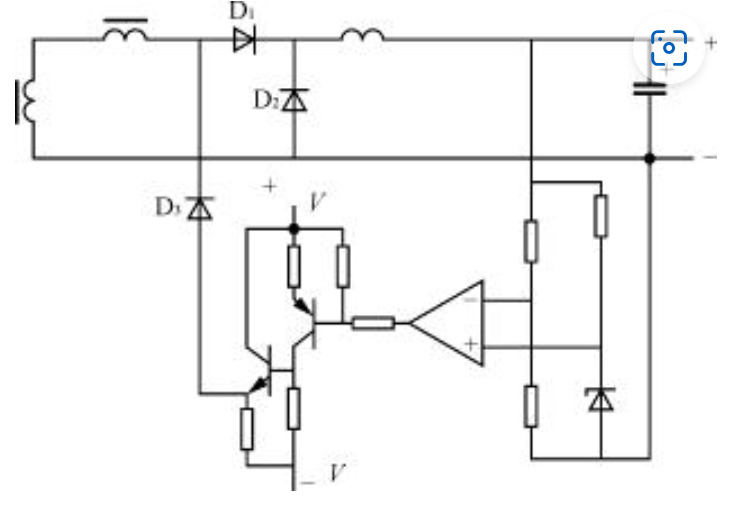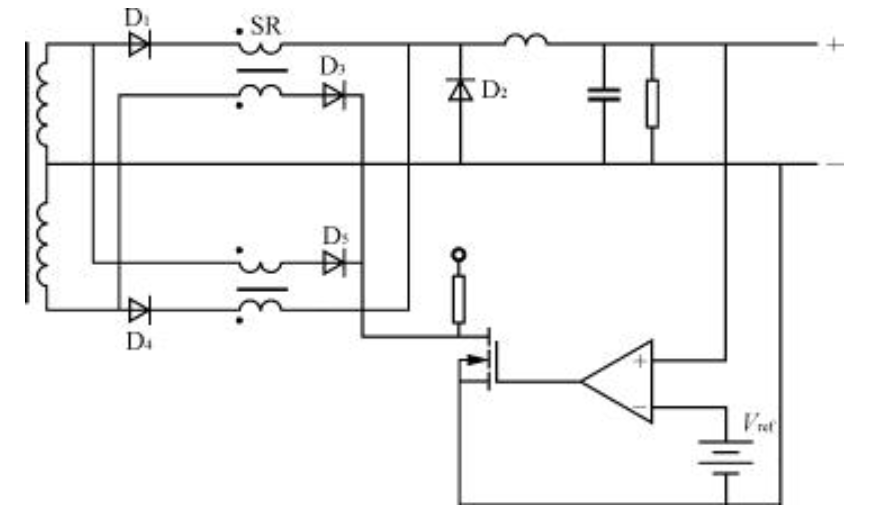Application Of Saturated Inductor In Switching Power Supply
2023/9/20 18:01:45The saturation inductor is an inductor with a high hysteresis loop rectangular ratio, high initial magnetic permeability, small coercive force, and an obvious magnetic saturation point. It is often used as a controllable delay switching element in electronic circuits. Due to its unique physical properties, it has been increasingly widely used in switching noise suppression of high-frequency switching power supplies, voltage stabilization of high-current output auxiliary circuits, phase-shifted full-bridge converters, resonant converters and inverter power supplies.
First: Classification of saturated inductors
1. Classification of saturated inductors
Saturated inductors can be divided into two categories: self-saturation and controllable saturation.
1.1 Self-saturating inductance
Its inductance changes with the amount of current passing through it. If the magnetic properties of the core are ideal (for example, rectangular), as shown in Figure 1(a), then the saturated inductor works like a "switch", that is, the current in the winding is small, the core is not saturated, and the winding inductance is large. , which is equivalent to an "open circuit"; when the current in the winding is large, the core is saturated and the winding inductance is small, which is equivalent to a "short circuit" in the switch.
1.2 Controllable saturation inductance
Also known as a controllable saturable reactor, its basic principle is that under the action of DC excitation of an AC coil with an iron core, due to the simultaneous excitation of AC and DC, the state of the iron core changes according to the local magnetic loop within one cycle. Therefore, the equivalent value of the iron core is changed. Magnetic permeability and coil inductance. If the core magnetic characteristics are ideal (the B-H characteristics are rectangular), the controllable saturation inductance is similar to a "controllable switch". In switching power supplies, the application of controllable saturation inductors can absorb surges, suppress spikes, eliminate oscillations, and reduce rectifier losses when connected in series with fast recovery rectifiers. As shown in Figure 1(b), the controllable saturation inductor has a high hysteresis loop squareness ratio (Br/Bs), high initial permeability μi, low coercive force Hc, and obvious magnetic saturation points (A, B ) and its high-frequency hysteresis loss is small due to the small area surrounded by its hysteresis loop. For this reason, the two salient features of controllable saturation inductors in application are:
1) Since the saturation magnetic field strength is very small, the energy storage capacity of the saturable inductor is very weak and cannot be used as an energy storage inductor.
The theoretical value of the maximum energy storage Em of the saturable inductor can be expressed by equation (1).
Em=μVH2/2 (1)
In the formula: μ is the magnetic permeability at the critical saturation point; H is the magnetic field intensity at the critical saturation point; V is the effective volume of the magnetic material.
2) Since the initial magnetic permeability of the saturable inductor is high, the magnetic resistance is small, and the inductance coefficient and inductance are large. When an external voltage is applied, the initial current inside the inductor grows slowly. Only after a delay of Δt, when When the current in the inductor coil reaches a certain value, the saturable inductor will be saturated immediately, so it is often used as a controllable delay switching element in circuits.

(a) Ideal magnetic properties B=f(H) (b) B=f(H) of saturable inductor
Figure 1 B-H characteristics of saturated inductor
2.1 Spike suppressor
The peak interference in the switching power supply mainly comes from the turn-on and turn-off moments of the power switch tube and the secondary side rectifier diode. Saturated inductors with the characteristics of easy saturation and weak energy storage capacity can effectively suppress this spike interference. The saturated inductor is connected in series with the rectifier diode. At the moment when the current rises, it presents a high impedance and suppresses the peak current. After saturation, the saturated inductance is very small and the loss is small. This saturable reactor is usually used as a spike suppressor.
In the circuit shown in Figure 2, when S1 is turned on, D1 is turned on and D2 is turned off. Due to the current limiting effect of the saturable inductor Ls, the amplitude and rate of change of the reverse recovery current flowing in D2 will be significantly reduced. This effectively suppresses the generation of high-frequency conduction noise. When S1 is turned off, D1 is turned off and D2 is turned on. Since Ls has a conduction delay time Δt, this will affect the freewheeling effect of D2 and produce a negative peak voltage at the negative electrode of D2. To this end, an auxiliary diode D3 and resistor R1 are added to the circuit.

Figure 2 Application of spike suppressor
2.2 Magnetic amplifier
The magnetic amplifier uses the physical characteristics of the controllable saturation inductor conduction delay to control the duty cycle and output power of the switching power supply.
The switching characteristics are controlled by the feedback signal of the output circuit, that is, the switching function of the magnetic core is used to control the voltage pulse width through weak signals to achieve the stability of the output voltage. By adding appropriate sampling and control devices to the controllable saturable inductor and adjusting its conduction delay time, the most common magnetic amplifier voltage stabilizing circuit can be formed.
There are two types of magnetic amplifier voltage stabilizing circuits: voltage type control and current type control. Figure 3 shows the voltage-type reset circuit, which includes voltage detection and error amplification circuit, reset circuit and control output diode D3. It is a single closed-loop voltage regulation system.

Figure 3 Magnetic amplifier voltage type reset voltage stabilizing circuit
Figure 4 shows the phase-shifted full-bridge ZVS-PWM switching power supply magnetic amplifier regulator. The secondary double half-wave rectifier of the full-bridge switching circuit transformer is each connected to a magnetic amplifier SR, and its core is wound with a working winding and a control winding. In the positive half cycle, when an output rectifier tube is forward biased (the other output rectifier tube is reverse biased), the square wave pulse output from the secondary side of the transformer is added to the corresponding working winding, causing the SR core to be magnetized (magnetized) in the negative direction; For half a cycle, the output rectifier is reverse biased, and the diode D3 connected in series with the control winding is forward biased and conducts. Under the action of the DC control current Ic, the core of the SR is demagnetized (reset).

Figure 4 Phase-shifted full-bridge ZVS-PWM switching power supply magnetic amplifier regulator
The working principle of the control circuit is: after the output voltage of the switching power supply is compared with the reference, the gate of the MOS tube is controlled through error amplification. The MOS tube provides the control current Ic of the magnetic amplifier SR related to the output voltage.
2.3 Phase-shifted full-bridge ZVS-PWM converter
The phase-shifted full-bridge ZVS-PWM converter combines the advantages of zero-voltage switching quasi-resonant technology and traditional PWM technology. The operating frequency is fixed. During the commutation process, LC resonance is used to make the device zero-voltage switching. After the commutation is completed, it still remains It uses PWM technology to transmit energy, has simple control, small switching loss and high reliability. It is a soft switching circuit suitable for large and medium power switching power supplies. But when the load is very light, especially the ZVS condition of the lagging arm switch tube is difficult to meet. Using the saturated inductor as the resonant inductor of the phase-shifted full-bridge ZVS-PWM converter can expand the range of switching power supplies that meet ZVS conditions under light load. Applying it to arc welding inverter power supply can reduce the loss of additional loop energy and effective duty cycle. On the basis of ensuring efficiency, it expands the load range of zero-voltage switching and improves the performance of soft-switching arc welding inverter power supply. reliability.
Connecting the saturated inductor in series with the secondary output rectifier of the isolation transformer of the switching power supply can eliminate secondary parasitic oscillations, reduce circulating energy, and minimize the duty cycle loss of the phase-shifted full-bridge ZVS-PWM switching power supply. In addition, the saturated inductor and capacitor are connected in series to the phase-shifted full-bridge ZVS-PWM switching power supply transformer, and the super forearm switch tube works according to ZVS; when the load current approaches zero, the inductance increases, preventing the current from reversing The change creates the ZCS condition of the lagging arm switch tube and realizes the phase-shifted full-bridge ZV-ZCSPWM converter.
2.4 Resonant converter
A series resonant converter using a series inductor or a saturated inductor is shown in Figure 5. When the resonant inductor current works in a continuous state, the switching tube is turned off at zero voltage/zero current, but it is hard turned on and there is a turn-on loss. The anti-parallel diode is naturally turned on, but has a reverse recovery current when turned off. Therefore, the anti-parallel diode must use a fast recovery diode. In order to reduce the turn-on loss of the switch tube and achieve zero-current turn-on, the switch tube can be connected in series with an inductor or a saturated inductor. Before the switch is turned on, the saturated inductor current is zero. When the switch tube is turned on, the saturation inductance limits the current rise rate of the switch tube, causing the switch tube current to slowly rise from zero, thereby achieving zero current turn-on of the switch tube, while improving the turn-off conditions of the diode and eliminating the reverse recovery problem. .

Figure 5 Resonant converter
2.5 Inverter power supply
Inverter power supply is widely used in various aspects such as automatic control, power electronics and precision instruments due to its good control performance, high efficiency, small size and many other advantages. Its performance is closely related to the quality of the entire system, especially the dynamic performance of the power supply. Due to the characteristics of the inverter power supply itself, its dynamic characteristics have always been unsatisfactory. The working principle of an inverter power supply controlled by PWM and PFM determines that in order to obtain a smooth current and voltage waveform, a freewheeling inductor must be added to its output circuit, and this inductor is the main factor affecting the dynamic performance of the inverter power supply. For a constant voltage source, the inductor current is completely inversely proportional to the load; for a controllable constant current source, in order to change the inductor current from small to large, a small load value must be used as the premise. Although it is not a complete correspondence, it can be said Changes in current reflect changes in load to some extent. Therefore, using an inductor that decreases as the current increases as the output inductor of the inverter power supply can effectively change the time constant T of the power supply output circuit, making it completely inversely proportional to R (T=L/R), and then in the load Maintaining a relatively small value within the variation range will naturally improve dynamic performance.
Technical Papers